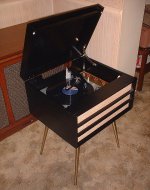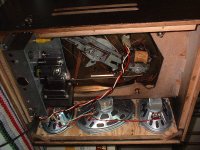At Oregon State University in 1963, my friend had a simple mono system. The giant speaker was too big to have 2 of them in a dorm room.
Turntable, Knight (Empire) cartridge connected to add L and R, Mono and Stereo LPs, Knight Kit 12AX7, 12AU7, and push pull EL84s. The speaker was an all Electro Voice system: 12 inch wolverine, 3.5k crossover, and an T35 Tweeter. The large enclosure was the Marquise with an expanding port (a short horn, coupled to the wall behind the enclosure).
We listened at low volumes. The classical music had tremendous life like sound and detail.
Perhaps it was that at low volumes, the harmonic and intermodulation distortion of both the amplifier and speaker was below the limit of hearing.
And back then, our ears were as good as they were ever going to be.
Whatever reason there was, we never forgot how impressed we were with that system.
Sometimes we get carried away with our super-complex amplifiers and systems.
Have you had a similar experience with an old simple/humble system that you heard decades ago?
Turntable, Knight (Empire) cartridge connected to add L and R, Mono and Stereo LPs, Knight Kit 12AX7, 12AU7, and push pull EL84s. The speaker was an all Electro Voice system: 12 inch wolverine, 3.5k crossover, and an T35 Tweeter. The large enclosure was the Marquise with an expanding port (a short horn, coupled to the wall behind the enclosure).
We listened at low volumes. The classical music had tremendous life like sound and detail.
Perhaps it was that at low volumes, the harmonic and intermodulation distortion of both the amplifier and speaker was below the limit of hearing.
And back then, our ears were as good as they were ever going to be.
Whatever reason there was, we never forgot how impressed we were with that system.
Sometimes we get carried away with our super-complex amplifiers and systems.
Have you had a similar experience with an old simple/humble system that you heard decades ago?
Just curious, why do you need so much gain? What source are you using?
Thanks for the links..........not really "so much" but just a reasonable amount, I figured this amp would be a bit more powerful than my single-ended amps (both watts and delivery) but it sounds muted. I did spend a few hours listening to classical near-field last night, through some cheap Klipsch bookshelfs and it did sound quite nice in that setting.
Last edited:
I designed this PP 6V6 amp for a phono system a while back.
Sounds great too.
The extra gang of the tone control on the phase inverter grid is inside the NFB loop where it could cause a problem. NFB properly applied tries to keep the gain across the band constant.
The other part of the tone control normally does all the work.🙂
The extra gang of the tone control on the phase inverter grid is inside the NFB loop where it could cause a problem. NFB properly applied tries to keep the gain across the band constant.
The other part of the tone control normally does all the work.🙂
Ah but however, there's no problems with that amp.
All that 2M/.0047u does is reduce or allow the treble feeding into the PI, in tandem with the other treble control, which feeds a bit of highs into the volume control.
Trust me, it works just fine. 😉
Here's the unit it's in, a small consolette phono.
Attachments
Doesn’t even look like it has an *open loop* gain of 150. That 6V6 stage is probably just about breaking even, and I back of the envelope calculate the front end gain to be about 85.
The original amp from the consolette used a pair of 35C5's and small OT's, so was weak in the bass department.
Also, the front baffle was replaced with 3 full range 12 ohm speakers in parallel
My "improvements" overall result in punchy bass, sparkling treble, and turned out better than expected.
After stripping the cabinet down, a couple coats of satin black, and new grille cloth, it makes a world of difference.
Also, the front baffle was replaced with 3 full range 12 ohm speakers in parallel
My "improvements" overall result in punchy bass, sparkling treble, and turned out better than expected.
After stripping the cabinet down, a couple coats of satin black, and new grille cloth, it makes a world of difference.
Attachments
Last edited:
35C5s are pretty woosy - designed to run off 110 VDC and less emissions than the 50 volt version. Can’t get much power. You really need a couple of watts to get ‘punchy’ anything. With 320 volts you’re getting somewhere.
Is that a pair of 5x7’s and a 6x9, or is the big one bigger?
Is that a pair of 5x7’s and a 6x9, or is the big one bigger?
35C5s are pretty woosy - designed to run off 110 VDC and less emissions than the 50 volt version. Can’t get much power. You really need a couple of watts to get ‘punchy’ anything. With 320 volts you’re getting somewhere.
Is that a pair of 5x7’s and a 6x9, or is the big one bigger?
Yes, the center speaker's a 6x9, all of them 12 ohms.
The amp chassis and speakers were taken from an old VM phono, similar in size.
I used the original OT and power OT, but completely re-did the amp to the above schematic in my previous post.
I also had to rotate the 5Y3G tube socket, because in horizontal use the tube must be oriented with pins 2 and 8 in the horizontal plane.
Adding a heat shield helps to keep from cooking the changer above those tubes.
So basically, the whole front baffle is loaded with cones, and the result is beefy bass that you can hear in another room.
The record changer's an RCA, taken from an old 1963 stereo console, but wired for mono with a different better cartridge.
One of my customers gave me a set of tapered legs that were optional for that table model cabinet.
Last edited:
At frequencies the speakers can actually reproduce, which are quite high - with fs around 70-ish, you can play it quite loud before it feeds back. If you had speakers that can reproduce 30 Hz or below, you would have a real problem. Most of the feedback issues I’ve had in my early DJing days happened at sub-audible frequencies. The woofers would just start flapping, then the DC protect relays on the amps trip to stop it.
35C5s are pretty woosy - designed to run off 110 VDC and less emissions than the 50 volt version. Can’t get much power. You really need a couple of watts to get ‘punchy’ anything. With 320 volts you’re getting somewhere.
Is that a pair of 5x7’s and a 6x9, or is the big one bigger?
I did one with PP 36L6s, 170V on the plates & running thru a Hammond 125D at the beginning of time. It made a honest 6 watts. With some NFB, without digging out the file I think the DF was something like 2-3. Sound depended on the loudspeaker used as usual.🙂
Looks nice but what about acoustic FB to the TT?🙂
None to speak of from that consolette, even at higher volume levels.
It retains that "warm" 1950's tube sound with some added punch, clarity and power.
And the RCA changer, while being completely overhauled, has some minor enhancements done, and tracks records nicely at a respectable 4 grams.
Attachments
Who made the RCA TTs? Always thought the name RCA was kind of a catchall, a marketer like Sears. RCA just put their name on the product.🙂
My previous reference should have read PP 35L6s, not 36L6s.😱
My previous reference should have read PP 35L6s, not 36L6s.😱
Who made the RCA TTs? Always thought the name RCA was kind of a catchall, a marketer like Sears. RCA just put their name on the product.🙂
My previous reference should have read PP 35L6s, not 36L6s.😱
The RCA "Studiomatic" changer was RCA-made and designed.
They made their own changers up into the 1970's, some with variable speed and strobe too, even synchronous motor models.
Sadly, now-a-days, the RCA name has been bought by a chinese company, no longer American, no longer reliable comes from it.
The massive name-stealing of vintage American brands (many) to asian corps was a sneaky sort of thing.....
People who bought American, relied on it, so the idea was to grab the name, make crap, and fool the masses, hoping "brand loyalty" was enough to sell their stuff.
And it worked, for a while, until people saw the lousy quality, and went with something else.
Slogans no longer represent the true originals....
"RCA...... the most Trusted name in Electronics (no more!)
"Zenith.... the Quality goes in before the name goes on" (not no more it doesn't!)
You can be Sure........ if it's Westinghouse!" (sure to break down now)
And on and on...
Pick a brand, they're all "gone".
- Home
- Amplifiers
- Tubes / Valves
- Too simple? Need some redesign advice



